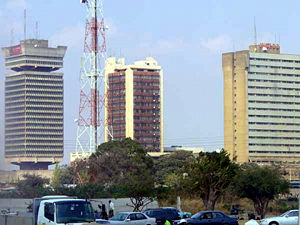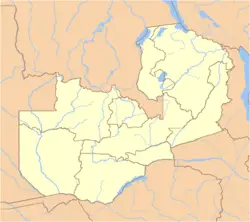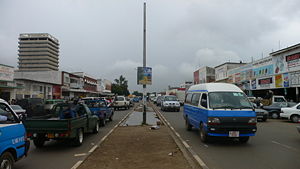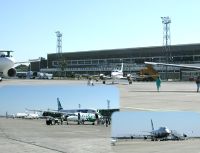Lusaka
| Lusaka | |
| Downtown Lusaka,2003 | |
| Location of Lusaka | |
| Coordinates: 15°25′S 28°17′E | |
|---|---|
| Country | Zambia |
| Province | Lusaka |
| Established | 1905 |
| City status | August 25 1960 |
| Government | |
| - Mayor of Lusaka | Steven Chilatu |
| Area | |
| - Total | 70 km² (27 sq mi) |
| Elevation | 1,300 m (4,265 ft) |
| Population (2000) | |
| - Total | 1,084,103 |
| Time zone | SAST (UTC+2) |
| Area code(s) | (1) |
| Website: http://www.lcc.gov.zm/ - Lusaka City Council | |
Lusaka is the capital and largest city of Zambia. It is located in the southern part of the central plateau of the country, at an elevation of 1300 m (4256 ft). It has a population of 1,084,703 (2000 census) and is considered one of the fastest growing (in terms of population) cities in Africa. It is a commercial centre as well as centre of government, and the four main highways of Zambia radiate north, south, east and west from it.
Government and administration
As national capital, Lusaka is the seat of the legislative, executive and judicial branches of government, epitomised by the presence there of the National Assembly (parliament), State House (office of the President), and the High Court. The city is also capital of Lusaka Province, the smallest and second most populous of the country's nine provinces, and forms an administrative district run by Lusaka City Council. In 2007, the mayor is Steven Chilatu (PF), and the deputy Mayor is Mary Phiri.
History
Lusaka was the site of a village named after its headman Lusaka, which, according to history, was located at Manda Hill, near where the Zambia's National Assembly building now stands. In the Nyanja language, Manda means graveyard. The area was expanded by European (mainly British) settlers in 1905 with the building of the railway.
In 1935, due to its fairly central location, its situation on the railway and at the crossroads of the Great North Road and Great East Road, it was chosen to replace Livingstone as the capital of the British colony of Northern Rhodesia.
After the federation of Northern and Southern Rhodesia in 1953, it was a centre of the independence movement amongst some of the educated elite that led to the creation of the Republic of Zambia. In 1964, Lusaka became the capital of the newly independent Zambia.
In recent years, Lusaka has become a popular urban settlement for Zambians and tourists alike. Its central nature and fast growing infrastructure sector has increased donor confidence and as such Zambians are seeing signs of development in the form of job creation, housing, etc. Consequently, it is thought that with proper and effective economic reforms, Lusaka as well as Zambia as a whole will develop considerably. Lusaka is home to a diverse community of foreigners, many of whom work in the aid industry as well as diplomats, representatives of religious organizations and some business people.
Culture
The city centre includes several blocks west of Cairo Road, around which lie the New City Market and Kamwala Market, a major shopping area, as well as the Zintu Community Museum. Further east lies the government area, including the State House and the various ministries, around the Cathedral Hill and Ridgeway areas. Suburbs around Lusaka include Woodlands, Kabulonga, Sunningdale, Jesmondine, Northmead, Olympia Park, Roma, Kalundu, Chelston, Avondale, Rhodes Park, Prospect Hill, Longacres, Fairview, Thorn Park, Villa Elizabetha. Other residential areas are Kabwata (a working class area, home to the Kabwata Cultural Centre), Madras, Matero, Kalingalinga, Chipata Compound, Garden Compound, Bauleni, Helen Kaunda, Kaunda Square (stage one and stage two). One of the main streets and points of interest upon business is the street of Cairo Road named by John Floria Couvaras of the Couvaras family.
Points of interest
Attractions include Lusaka National Museum, the Political Museum, the Zintu Community Museum, the Freedom Statue, the Zambian National Assembly, the Agricultural Society Showgrounds (known for their annual agricultural show), the Moore Pottery Factory, the Lusaka Playhouse theatre, a cinema, the Cathedral of the Holy Cross in , a cenotaph, a golf club, the Lusaka Central Sports Club, and the zoo and botanical gardens of the Munda Wanga Environmental Park. The city is also home to the University of Zambia.
List of mayors
- Morris Doe
- Ralph Rich
- Jack Fischer
- Richard Sampson
- Fisho Mwale
- John Kabungo
- Patrick Kangwa
- Susan Nakazwe
- Stephen Chilatu
Airport
The city is home to Lusaka International Airport and lies on the railway line from Livingstone to Kitwe. This airport is the hub of Zambian Airways. The airport is used as a public and military airport. There is also an old airport nearer to the center of the city that is no longer used by civilians.
2011 All African Games
Lusaka will host the 2011 All-Africa Games. A new stadium of a 70,000 capacity will be built in Lusaka for the games. This is the first time the country has held the games, and games related development is contributing to some city-wide redevelopment.
Sister cities
 Dushanbe, Tajikistan, since 1966
Dushanbe, Tajikistan, since 1966 Los Angeles, United States, since 1968
Los Angeles, United States, since 1968 Izhevsk, Russia. [1]
Izhevsk, Russia. [1]
External links
- Lusaka City Council
- Zambia Tourism page on Lusaka
- Map of Lusaka
- Visit Zambia Campaign
- Lusaka Social Centre
- Lusaka Times
- Zambia Online
- Schools and Colleges of Lusaka
ReferencesISBN links support NWE through referral fees
Credits
New World Encyclopedia writers and editors rewrote and completed the Wikipedia article in accordance with New World Encyclopedia standards. This article abides by terms of the Creative Commons CC-by-sa 3.0 License (CC-by-sa), which may be used and disseminated with proper attribution. Credit is due under the terms of this license that can reference both the New World Encyclopedia contributors and the selfless volunteer contributors of the Wikimedia Foundation. To cite this article click here for a list of acceptable citing formats.The history of earlier contributions by wikipedians is accessible to researchers here:
The history of this article since it was imported to New World Encyclopedia:
Note: Some restrictions may apply to use of individual images which are separately licensed.







